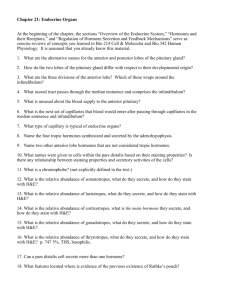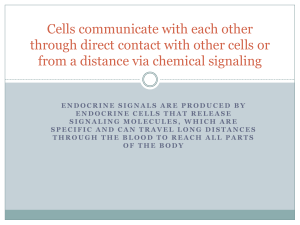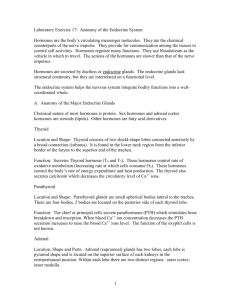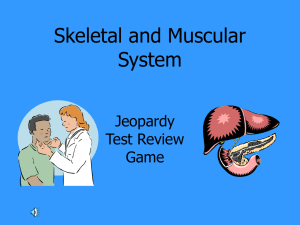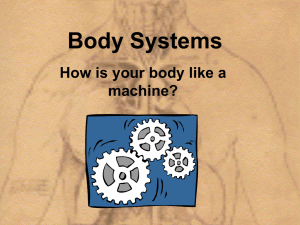Endocrine
advertisement
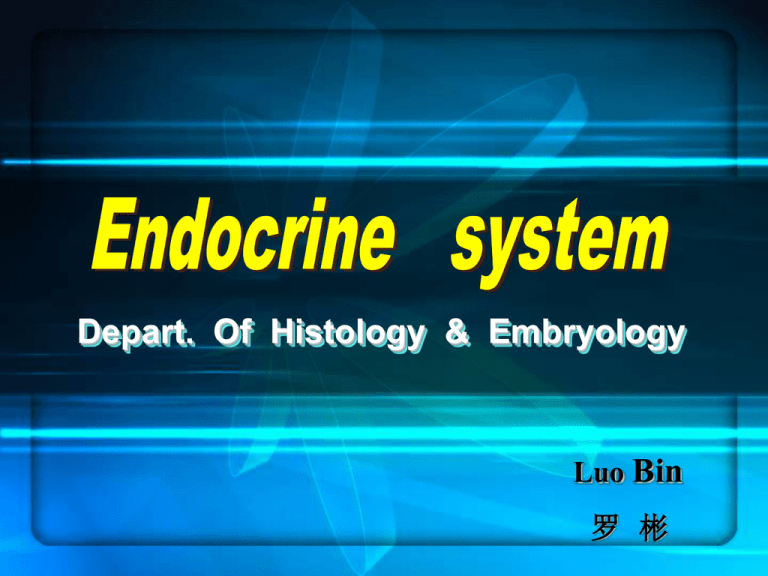
Depart. Of Histology & Embryology Luo Bin 罗 彬 Why can you grow up? General description • Components Endocrine glands Endocrine tissues ( Pancreas islet ) Endocrine cells • Function Endocrine system target organs produce Hormones Act on target cells What is hormone? Hormones are molecules that function in the body as chemical signals. Endocrine glands Thyroid gland Adrenal glands Pituitary gland General description • Components Endocrine glands Endocrine tissues ( Pancreas islet ) Endocrine cells • Function Endocrine system target organs produce Hormones Act on target cells What is hormone? Hormones are molecules that function in the body as chemical signals. Hormones secretion Special secreting forms Autocrine (自分泌) Paracrine (旁分泌) common features ⑴ Ductless ⑵ Endocrine cells arrange into nests, cords, clusters or follicles ⑶ Rich in capillaries Two types of endocrine cells Steroid-hormone secreting cell 类固醇激素分泌细胞 Nitrogenous-hormone secreting cell 含氮激素分泌细胞 Thyroid gland • General structure --- capsule : L.C.T forming septa --- parenchyma: lobules follicles interstitium: CT Thyroid gland follicles Constitution: Follicle: Colloid is surrounded by a single layer epithelium. 1. Epithelium: Simple squamous (hypoactive), cuboidal or columnar (hyperactive), depending upon the functional status. 2. Colloid: Homogeneous secretion of epithelium. Acidophilic and PAS (+). Contains iodinated thyroglobulin. Thyroid gland follicles Follicular epithelial cells EM: • microvilli • RER, Golgi apparatus secretory granules • lysosome, mitochondria endocytotic vesicles Function: synthesize and release thyroid hormones According to the structures of follicular epithelial cells, 四碘甲状腺原氨酸 thyroxine can you(T4) illustrate their functions? triiodothyronine (T3) 三碘甲状腺原氨酸 What is the secretory process? i. Synthesis of thyroglobulin ii. Iodination of thyroglobulin iii. Release of thyroid hormones Formation of T3 & T4: a. AA→ RER→ thyroglobulin → (Gogi, glycosylated→ (G, secreting granules) → colloid. b. Iodide → (iodide pump) → iodide oxidation in cytoplasm → colloid → bound to tyrosine residues of thyroglobulin → iodated thyroglobulin. c. iodated thyroglobulin → (TSH, microvilli) → endocytic vesicles →LYS → T3 & T4. Function of T3, T4: a. elevate the basal metabolic rate. b. influence the body growth and nervous system development during fetal life. Modulation of T3, T4 secretion: hypothalamus-pituitary-thyroid axis Pathological state In adults, thyroid hormone overproduction underproduction Thyroid hormone deficiency slows A consequence of an increase in body processes: hyperthyroidism body’s metabolism: hypo thyroidism Clinical features: Clinical features: ★ dry, puffy skin ★ feeling hot ★ inability to keep warm ★ increased sweating ★ weight gain ★ weight loss, with poximal ★ a slow heart rate ★ loss of energy and appetite ★ ★ constipation ★ anxiety and restless hyperactivity muscle weakness ★ exophthalmic goiter rapaid heart rate diarrhoea myxoedema Pathological state Hypothyroidism present at birth: Mental retardation Short stature Coarse facial features Protruding tongue Umbilical hernia Parafollicular cell ---single between follicular cells ---in small groups in interstitial tissue Also called calcitonin cell / C cell LM: • ovoid, polygonal • larger • pale-stained: eosinophilic • argyrophilic granules Function: synthesize and release calcitonin, make blood calcium Parathyroid gland • Structure capsule parenchyma glandular cells stroma chief cells oxyphil cells • Function synthesize parathyroid hormone (PTH) make blood calcium Adrenal gland ---capsule: CT ---cortex: yellow, derived from mesoderm 内胚层 ---medulla: reddishbrown, derived from neural ectoderm 神经外胚层 Adrenal gland cortex Zona glomerulosa 球状带 Zona glomerulosa Zona fasciculata 束状带 Zona fasciculata Zona reticularis 网状带 Zona reticularis Zona glomerulosa 15% of cortex volume ---Structure: LM cells: small, low columnar or polygonal be arranged into nests or clusters nuclei: deep stained, round cytoplasm: light basophilic ---Function: secrete mineralocorticoid ( eg. aldosterone) 盐皮质激素 醛固酮 regulate electrolyte and water balance Zona fasciculata About 78% of cortex volume ---Structure: LM cells : large,clear margin be arranged in straight cords cytoplasm: light staining appear vacuolated(formy)-empty ---Function: secrete glucocorticosteroid 盐皮质激素 (e.g cortisol、corticosterone) and androgen 雄激素(less) regulate carbohydrate, protein and lipid metabolism influence immune response Zona reticularis 7% of cortex volume ---Structure: LM cells: polyhedral and small; be arranged in irregular anastomosing cords cytoplasm: acidophilic ---Function: secret androgen(testosterone) and small amount of oestrogen 雌激素 Adrenal medulla ---Structure: medullary cell ( chromaffin cell ) : LM: cells: polyhedral, be arranged in nests or short cords cytoplasm: weakly basophilic, brownish granules- when fixed by bichromate-containing fixative. central vein ganglial cells: multipolar neurons large, 2~3 in groups Adrenal medulla EM electron-dense granules Noradr. cell adrenaline cell: 80% 肾上腺素细胞 i. heart rate ii. dilate blood vessel Adr. cell noradrenaline cell: 20% 去甲肾上腺细胞 i. blood pressure ii. the flow speed of blood ---Function: secrete adrenaline and noradrenaline secrete some polypeptides(galanin, neuropeptide Y, enkephalin) Pathological state Excessive adrenal secretion of glucocorticoid hormones Cushing’s syndrome Pituitary gland capsule: CT adenohypophysis 腺垂体 pars distalis anterior lobe 远侧部 前叶 pars tuberalis 结节部 pars intermedia 中间部 pars nervosa neurohypophysis 神经垂体 神经部 infundibular stalk 漏斗柄 median eminence 正中隆起 posterior lobe 后叶 Pituitary gland Pituitary gland Infundibular Pars distalis Pars intermedia Pars nervosa Pas distalis Glandular cells are arranged in nests Rich in capillaries around the cells Classification: Chromophobes Acidophils Chromophils Basophils A --- Acidophil round or oval , eosinophilic stainning B --- Basophil less, large cell, ovoid or polygonal basophilic granules C --- Chromophobe more, small, pale, no clear boundary Tropic hormones of pas distalis cell type secreting hormone somatotrope somatotropic hormone(STH) or growth hormone(GH) 生长激素细胞 acidophil mammotrope 催乳激素细胞 thyrotrope lactogenic hormone(LTH) or prolactin(PRL) thyroid stimulating hormone(TSH) 促甲状腺激素细胞 corticotrope basophil adrenocorticotropic hormone(ACTH) 促肾上腺皮质激素细胞 gonadotrope follicle stimulating hormone(FSH) luteinizing hormone(LH) 促性腺激素细胞 interstitial cell-stimulating hormone(ICSH)---male Pathological state Titan Pathological state growth hormone in kids deficient Dwarfism too much Gigantism Pathological state Too much growth hormone occurs in adults Acromegaly 肢端肥大症 Protruding jaw Broaden lower face Enlarged hands Pas intermedia Structure: chromophobe cells basophils be arranged into cords/follicles. Function: Secrete melanocyte-stimulating hormone (MSH) 黑素细胞刺激素 Pas tuberalis Secrete gonadotropin. Neurohypophysis Pars nervosa Components • Pituicytes ( glial cells) • Capillaries (fenestrated) • Unmyelinated nerve fibers Function: Store and release oxytocin and antidiuretic hormone (ADH) 催产素 抗利尿激素 Neurohypophysis Herring bodies: Neurosecretory granules accumulate in the dilated portions of the axons near their terminals. LM: acidophilic, irregular structure Blood supply (Hypophyseal portal system) Superior hypophyseal artery (Primary plexus)capillaries Hypophyseal portal vein (Secondary plexus) capillaries Hypophyseal vein Relationship between hypothalamus and adenohypophysis Arcuate nucleus of hypothalamus (neuroendocrine cell): • secrete releasing hormones (RH) -GRH, PRH, TRH, GnRH, CRH, MSRH • secrete release inhibiting hormones (RIH) -SOM, PIH, MSIH • their axons end in infundibular stalk and release hormones into primary capillaries network of hypophyseal portal circulation • positive and negative feedback 肾上腺皮质三带的比较 球状带 束状带 网状带 位置 被膜下 中层 深层,近髓质 厚度 最薄 最厚 较薄 78% 7% 体积比 15% 细胞排列 球状 毛细血管 球间血窦 细胞大小 较小 纵行的单或双行细胞索 细胞短索吻合成网 索间纵行血窦 网间血窦 大 小 形状 矮柱状或椎形 多边形 多边形 核 核小色深 核大圆色浅 核小色较深 胞质 少量脂滴 大量脂滴 少量脂滴,脂褐素 分泌激素 盐皮质激素 糖皮质激素 雄激素及少量糖皮质激素 作用 调节水盐代谢(排钾保钠) 糖异生、应激、抗炎、抑制免疫等 受调节 肾素-血管紧张素系统 电镜结构 较典型 ACTH 典型的类固醇激素细胞的 超微结构 蛋白质代谢 ACTH 较典型

